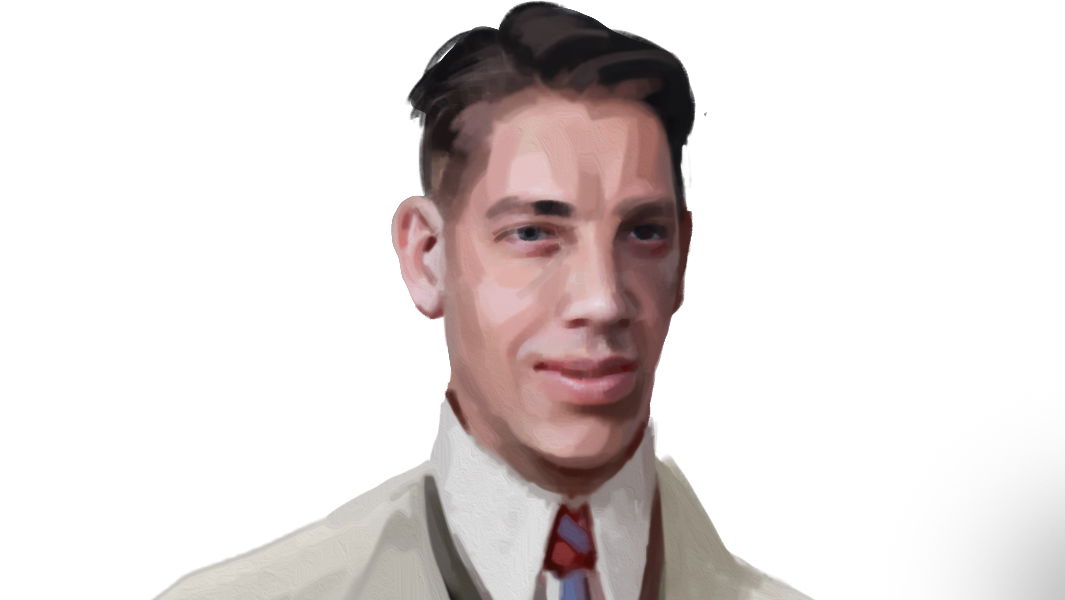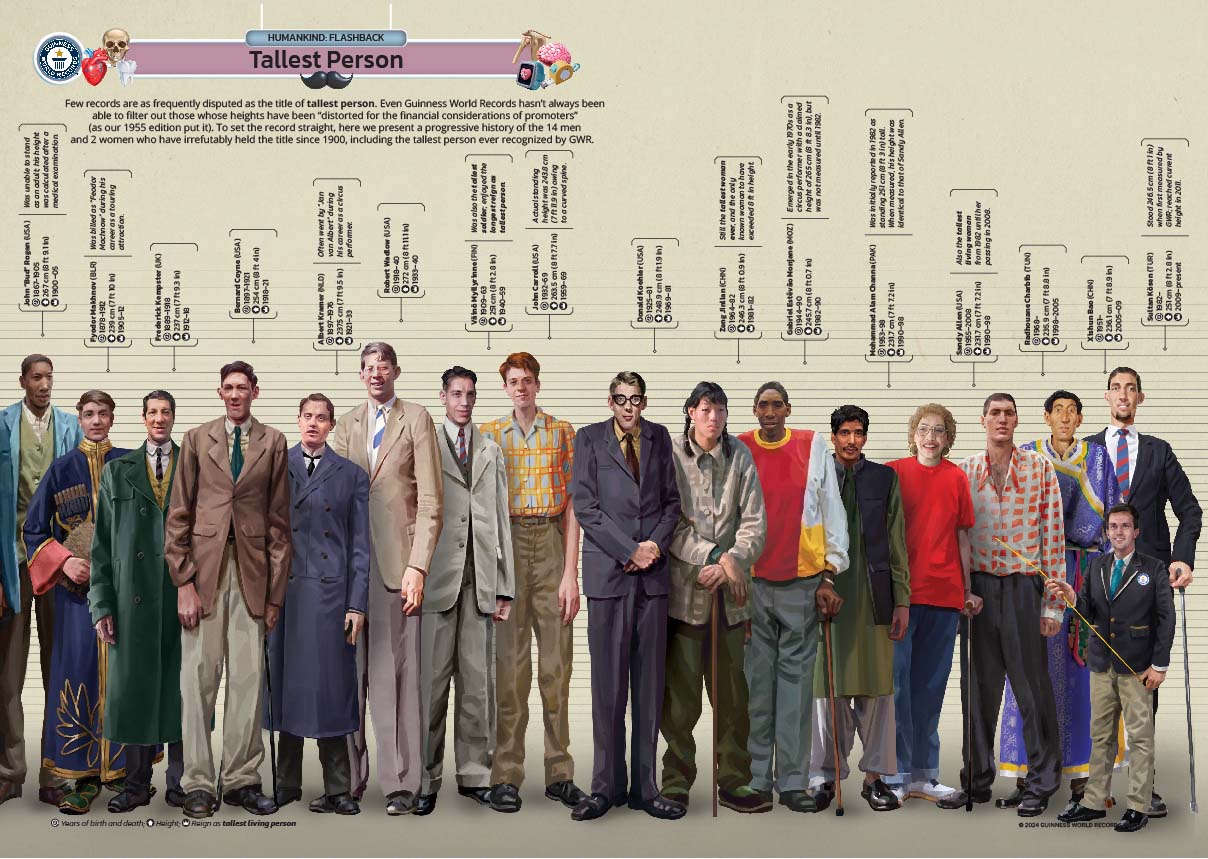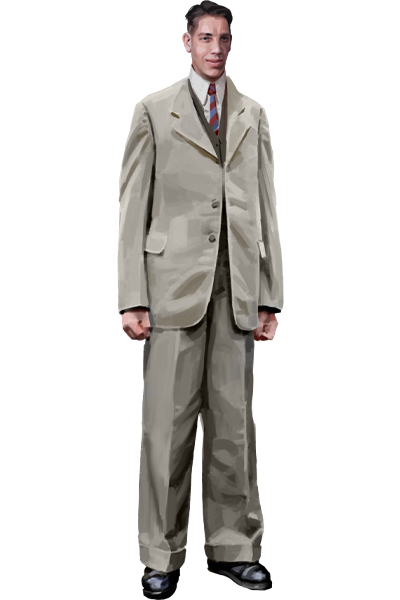Väinö Myllyrinne: A history of the world's tallest people

Following the tragic death of the tallest man in history on 15 July 1940, the record passed to someone who had been living in Robert Wadlow’s colossal shadow for almost a decade – the 8-ft-1.5-in-tall (247-cm) Finn Väinö Myllyrinne. By the time he gained the title, however, Väinö was already tired of show business, and had retired to a quiet life with his family in the countryside north of Helsinki.

Early life
Väinö Johannes Myllyrinne was born on 27 February 1909 in Helsinki, the capital of the Grand Duchy of Finland – then a province of the Russian Empire. His parents, Nestor and Anna-Maria, were both of ordinary size and build, as were his many brothers and sisters. His family moved several times during his childhood as his father, a police officer, changed assignments.
His birth weight was reportedly normal, and no-one seems to have seen anything unusual in his growth until the first few years of elementary school, when he began to quickly rise above his classmates. By the time he graduated from high school in 1927, he was 222 cm (7 ft 3 in) tall.
Despite his unusual growth and height, Väinö passed the physical examination for compulsory military service, and completed basic training in the late 1920s. His peacetime service in a heavy artillery regiment in Viipuri qualifies him as the tallest soldier ever.
Väinö Myllyrinne, Suomen pisin sotilas, 226 cm. #Sotilas #Suomi #puolustusvoimat #väinömyllyrinne pic.twitter.com/n4ZkUKV76X
— Apache (@ApacheQQ) September 22, 2022
Sporting ambitions
After completing his national service, Väinö moved in with his older brother Erkki and his family in Hesinki. He worked various jobs in the city, mostly in factories, commuting to and from work on a custom-made extra-large bicycle. In his free time Väinö trained with members of Helsingin Atleettiklubi (the Helsinki Athletics Club) with the hope that he could parlay his considerable strength and huge reach (he had an arm-span of 275 cm) into a career as a boxer or wrestler.
Eventually, however, Väinö had to concede that his reactions and movements were simply too slow for his sporting aspirations to ever become a reality. In 1935, he signed up with a travelling circus and began several years as a touring entertainer. His travels took him to Germany, Austria, Italy, Switzerland and France.
He made enough money during this time to enjoy a high standard of living. He dressed in tailor-made suits and bought himself a luxury car (a spacious US-made Marmon Sixteen), which he modified for his own use by removing the driver's seat so he could sit in the back with his feet on the pedals and his hands on the wheel.
Väinö Myllyrinne (27 February 1909 – 13 April 1963) was a Finnish acromegalic giant who was at one time (1940–1963) the world's tallest living person, and may have become the tallest after the death of Robert Wadlow. He stood 224 cm (7 ft 4 in) and weighed 141 kg (22 stone; 311… pic.twitter.com/AsR5U7wQxM
— Bazaar (@AboutBazaar) July 19, 2023
Wartime years
In early 1939, Väinö signed up with a promoter to go and tour in the US, but the outbreak of war in Europe meant that this next stage in his entertainment career never took place. Instead, he returned to Helsinki and spent the war working in a munitions factory while doing the occasional public appearance for the Finnish army. He married Anna-Liisa Puistonen in 1942 but the marriage broke down before the war's end and the couple had no children.
It was also during this period that Väinö experienced a second, unexpected period of growth. By the end of his 20s, Väinö's height was somewhere around 230 cm (7 ft 6.5 in), but for some reason his pituitary gland started overproducing growth hormones once again when he was in his thirties. This second period of growth saw Väinö's height increase to 247 cm (8 ft 1.5 in).
After the war, Väinö briefly returned to show business, but after a few short tours, mostly in neighbouring Sweden, he decided to retire. His health had declined during the war, and he no longer had the energy for life on the road.
A quiet life in Järvenpää
In 1947, Väinö bought a house with some land on the outskirts of Järvenpää, a town about 40 km north of Helsinki. The plot was on a narrow lane, hidden from the street by a thick hedge of fir trees, allowing Väinö to work outside without being seen by passers by. Here he kept chickens and lived in the midst of an orchard of apple trees that he'd planted.
Väinö, 2,5 m ... äitini albumista : Merikarvialta (Väinö Myllyrinne). Aikoinaan maailman pisin jätkä... pic.twitter.com/ukZ097yVNI
— Kari-Pekka Tuominen (@KPTuominen) April 17, 2023
The local grocers used to drive up the narrow lane to collect eggs and, in the autumn, apples from Vaino’s small farm, which was well known for its produce (and for its locally-famous owner). Väinö was particularly proud of his orchard, and spent a great deal of time experimenting with new varieties of apple trees, grafting and pruning to keep them healthy – a job made easier by the fact that he was almost as tall as the trees themselves.
Although he wasn’t wealthy, Väinö was able to add some comforts to his small homestead, including a separate sauna with 3 m (9 ft 10 in) ceilings so he could stretch out.
His mother moved in with him there, and his brother Erkki moved to the town with his family soon after. During the 1950s it was difficult for Väinö to travel, and so his home became a social hub for his family and friends. His nephews Kalervo and Kullervo would cycle round after school most days, and his brother visited often. Friends would regularly drive up from farther afield, including famous wrestlers, circus managers and musicians that he knew from his years on tour.
Much of what we know about his life comes from the recollections of Kalervo Myllyrinne, who took the time to write down his memories of life with “Uncle Väinö” in the 2000s.

Final years
In 1957, as the health of both Väinö and his mother began to decline, Erkki and his family moved into the house in the orchard to look after him. In the fall of 1962, the increasingly frail Väinö tripped and fell on the stairs, breaking his hip. Despite the efforts of local doctors, the fracture would not heal, and he was transferred to the Sädehoitolaitos cancer clinic in Helsinki. Various treatments were tried but his condition continued to worsen, he died on 13 April 1963. He was 54 years old, which is impressive considering the generally short lives of the people who have held the title of tallest man.
Väinö returned briefly returned to the public eye in 2004, when he was voted the 12th greatest Finn in history as part of a TV show called Suuret Suomalaiset (an adaptation of the British TV show Great Britons). However, while he is well known in his native country, this campaign was a bit of Finnish sarcasm: "suuret" means both "greatest" in the sense of "most important" but also in the sense of "largest". People who found the concept of a historical-figure popularity contest a bit silly voted for the "biggest Finn" as a joke.


